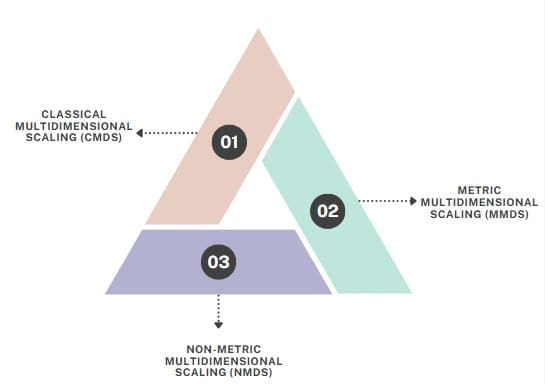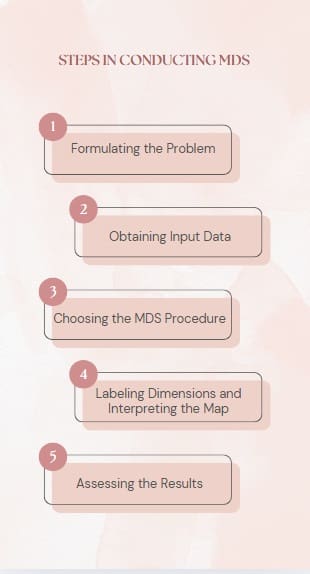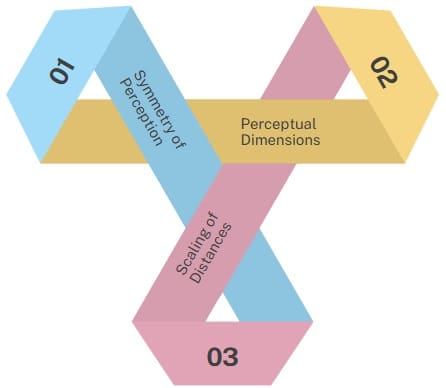Multidimensional Scaling (MDS) is a statistical technique that is used to visualize and understand the perception and preferences of individuals in relation to various stimuli. MDS provides a spatial representation of these perceptions, helping researchers understand the underlying dimensions that respondents use to make judgments about products, brands, or other items.
The primary goal of MDS is to reduce complex data into a simple visual format, often referred to as a spatial map or configuration. These maps help in identifying how similar or different items are based on respondents’ views.
Table of contents
Concept Behind MDS
At its core, MDS works by placing stimuli—such as brands, products, or other objects—on a multi-dimensional space. This space represents the psychological or perceptual dimensions that consumers use to assess the stimuli.
For example, when studying consumer perceptions of different car brands, MDS can help map out how brands are viewed in relation to each other based on attributes like luxury, price, or quality.
Types of MDS

There are different types of MDS, including:
Classical Multidimensional Scaling (CMDS)
Classical MDS, also known as Metric MDS, attempts to recover the original distances directly. It uses the distance matrix to calculate the coordinates of the objects in the lower-dimensional space. The algorithm minimizes the stress, a measure of how well the distances on the map match the original distances. This method is most suitable when the data consists of known distances.
Metric Multidimensional Scaling (mMDS)
In this method, the actual magnitudes of distances between objects are used. The distances are directly preserved in the reduced-dimensional space. Metric MDS is also known as Principal Coordinates Analysis (PCA).
Non-metric Multidimensional Scaling (NMDS)
Non-metric MDS, on the other hand, works with dissimilarity data where only the rank order of distances is available. In NMDS, the algorithm focuses on preserving the rank order of the distances rather than the actual distances. The goal is to place objects on a map so that their relative positions reflect the ranking of their dissimilarities.
Applications of MDS in Marketing
MDS has numerous applications in marketing and consumer research, including:
- Image Measurement: MDS is used to identify how customers view a company’s image compared to its own self-image.
- Market Segmentation: It helps in grouping consumers based on their similar perceptions of brands.
- New Product Development: MDS helps identify gaps in the market that may indicate opportunities for new products.
- Advertising Effectiveness: It can be used to assess whether advertising has successfully altered a brand’s position in the consumer’s mind.
- Pricing Analysis: MDS is used to analyze how price changes affect a brand’s position in the marketplace.
- Channel Decisions: It helps identify which retail outlets are best suited for different brands based on consumer perception.
- Attitude Scale Construction: MDS is also useful in constructing scales to measure consumer attitudes.
Steps in Conducting MDS

Formulating the Problem: The researcher must clearly define the objective of the MDS analysis, such as understanding consumer perceptions of a product or brand. The selection of brands or stimuli is also crucial. A balanced number of brands should be chosen to ensure meaningful results.
Obtaining Input Data: The input data can be gathered in different ways. It could be based on perceptions (direct or derived) or preferences. Perception data measures how similar or different various items are, while preference data assesses how much a respondent prefers one item over another.
Choosing the MDS Procedure: The researcher needs to select the appropriate MDS method based on the type of data they have. This could involve either non-metric or metric MDS, depending on whether the data is ordinal or continuous.
Labeling Dimensions and Interpreting the Map: Once a spatial map is generated, the researcher must label the dimensions based on subjective judgment. They can look for patterns or associations between attributes and dimensions.
Assessing the Results: It is essential to assess the quality of the results. This can be done by looking at the goodness-of-fit measures, such as R-squared and stress values, which indicate how well the MDS solution matches the input data.
Advantages of MDS
- It simplifies complex data and makes it easier to interpret.
- It helps uncover hidden relationships between items that may not be apparent through other methods.
- It is a flexible tool that can be applied in various fields, including psychology, marketing, and social sciences.
Challenges of MDS
- MDS assumes that the perceptions or preferences between two stimuli are the same, which may not always be true in reality.
- Interpretation of the results can be subjective, and there is no guarantee that the identified dimensions will have a clear and meaningful connection to the real-world attributes of the stimuli.
- The process of obtaining data and ensuring accuracy can be time-consuming.
Key Assumptions in MDS

MDS makes a few key assumptions that researchers need to be aware of:
Symmetry of Perception: MDS assumes that the similarity between two stimuli is the same in both directions (i.e., if stimulus A is perceived to be similar to stimulus B, then B is also perceived to be similar to A). However, this may not always hold true, especially in certain cases like geographical perceptions.
Perceptual Dimensions: MDS assumes that the distance between stimuli is a result of their differences across multiple perceptual dimensions, but in practice, it can be difficult to isolate these dimensions.
Scaling of Distances: When interpreting the results, it’s assumed that the spatial distances on the map represent true perceptual differences. However, this assumption may not always be accurate.
Role of Data in MDS
The input data plays a vital role in determining the success of MDS. There are different ways to collect data, including:
Similarity Judgments: Respondents rate how similar or dissimilar different stimuli are on a scale. For example, in a study of toothpaste brands, respondents may rate how similar one brand is to another.
Attribute-based Ratings: In this approach, respondents rate the attributes of each stimulus, such as price or quality. These ratings are then converted into similarity measures.
Preference Rankings: This method involves asking respondents to rank the stimuli in terms of their preferences. MDS uses these preferences to create a spatial map that reflects how much respondents like each brand or product.
Practical Example of MDS
One practical application of MDS can be found in color perception studies. In such studies, participants are asked to rate the similarity of different colors on a scale, and MDS is used to create a 2D map that reflects how similar or different the colors are from one another. The resulting map often reveals well-known patterns, like the color circle used in color theory.
Limitations of MDS
Despite its usefulness, MDS has certain limitations:
- Interpretation of Dimensions: While Multidimensional Scaling can create a spatial map, it doesn’t automatically provide clear labels for the dimensions. This requires subjective judgment, which can lead to ambiguity.
- Complexity in Large Data Sets: When working with large sets of stimuli, MDS can become computationally intensive and hard to manage.
- Assumption of Euclidean Distance: MDS assumes that the perceptual distances between stimuli can be represented as Euclidean distances, but in some cases, this may not be the best representation.
Applications of Multidimensional Scaling
MDS is used in a wide range of applications, particularly in fields where the relationships between objects are important but difficult to visualize in high-dimensional spaces.
Geostatistics: In geostatistics, MDS can be used to analyze spatial data. For example, it can help visualize how different geological features, such as mineral deposits, are related based on various measurements (e.g., mineral content, location, etc.).
Market Research: Companies use MDS to study consumer preferences. For example, MDS can help visualize how customers perceive the similarity or dissimilarity between different products or services.
Psychology and Social Sciences: MDS is commonly used to study human perceptions, preferences, and relationships. For instance, psychologists use MDS to analyze how individuals perceive various concepts, like emotions or personalities.
Clustering and Pattern Recognition: In machine learning and data analysis, MDS can help identify clusters or patterns within high-dimensional data. By visualizing the data in lower dimensions, MDS can help identify groups of similar items or trends in the data.
Final Words
Multidimensional Scaling is a powerful tool for understanding how individuals perceive and evaluate different stimuli. Whether it’s used to map consumer perceptions of brands or to explore how people perceive colors, MDS offers valuable insights that can inform decision-making across various industries.
By understanding its applications, methods, and limitations, researchers and marketers can harness MDS to drive strategies that better align with consumer preferences and perceptions.


















